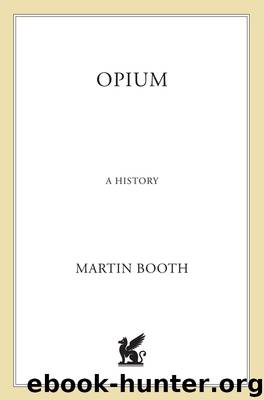Opium by Martin Booth

Author:Martin Booth
Language: eng
Format: epub
Publisher: St. Martin’s Griffin
10
Junkies and the Living Dead
For centuries, addiction was regarded as an unavoidable inconvenience of opiate consumption and rarely considered a problem: 100 years ago doctors frequently referred to users, without any alarm or censure, not as addicts but as ‘habitués’. Addiction was not seen as evil but a minor social vice although there was often an underlying apprehension it might lead to worse. This misgiving very slowly grew as the notion of addiction came to be feared and the addict came to be regarded as a corrupted, perverted menace. This change of opinion, the addict metamorphosing from harmless misfortunate to loathsome criminal, came, as did the first moves for international control, from the USA.
From its earliest years, America had an opium problem. It was used as a therapeutic medicine in the colonial era and was extensively relied upon during the War of Independence by both American and British forces, to the extent there was such a shortage some doctors, like Dr Thaddeus Betts, grew their own. In fact, at various times throughout American history, poppies have been cultivated in states ranging as widely as New Hampshire, Florida and California. As the post-colonial population expanded, and immigration increased, epidemics raged through the eastern states so that, by 1840, opium taking, both as a medicine and to maintain medically inspired addiction, was widespread. As well as laudanum, a Dr Barton invented what he called ‘The Brown Mixture’, a concoction of opium and liquorice similar to that of the ancient Assyrians, which also became a common medicine. By 1860, opium posed a major social issue in America, as it did in Europe, the American Civil War considerably magnifying the problem. An article by Fitzhugh Ludlow in Harper’s Magazine in 1867 stated:
The habit is gaining fearful ground among our professional men, the operatives in our mills, our weary serving women, our fagged clerks, our former liquor drunkards, our very day laborers, who a generation ago took gin. All our classes from the highest to the lowest are yearly increasing their consumption of the drug.
Furthermore, the patent medicine industry boomed with such opium containing concoctions as ‘Hooper’s Anodyne, the Infant’s Friend’ (a baby soothing syrup), although opiate usage was not as widespread as in Britain, for the people led different life-styles and the poor were not always so trapped in industrial ghettos but often living a more pastoral existence. Nevertheless, as opium began to gather a dubious reputation, the patent medicine industry held out against legislation for the publication of ingredients on labels. Many popular brands contained high levels of opium until 1906 when the Pure Food and Drugs Act came into force, after which people saw what they were taking and morphine and opium demand plummeted. It might be remembered not only opiates were involved. Until 1903 Coca-Cola contained cocaine: it was indeed ‘The Real Thing’ in those days. John Pemberton, its pharmacist co-inventor, was a morphine addict.
Not only opium addiction increased. Amongst the well-off, morphinism spread with the introduction of the hypodermic syringe, many of the addicts being society ladies.
Download
This site does not store any files on its server. We only index and link to content provided by other sites. Please contact the content providers to delete copyright contents if any and email us, we'll remove relevant links or contents immediately.
Nudge - Improving Decisions about Health, Wealth, and Happiness by Thaler Sunstein(7615)
iGen by Jean M. Twenge(5366)
The Fire Next Time by James Baldwin(5248)
Adulting by Kelly Williams Brown(4486)
The Hacking of the American Mind by Robert H. Lustig(4318)
The Sports Rules Book by Human Kinetics(4290)
The Ethical Slut by Janet W. Hardy(4172)
Captivate by Vanessa Van Edwards(3795)
Mummy Knew by Lisa James(3630)
In a Sunburned Country by Bill Bryson(3481)
The Worm at the Core by Sheldon Solomon(3432)
Ants Among Elephants by Sujatha Gidla(3417)
The 48 laws of power by Robert Greene & Joost Elffers(3023)
Suicide: A Study in Sociology by Emile Durkheim(2971)
The Slow Fix: Solve Problems, Work Smarter, and Live Better In a World Addicted to Speed by Carl Honore(2947)
Humans of New York by Brandon Stanton(2835)
The Tipping Point by Malcolm Gladwell(2826)
Handbook of Forensic Sociology and Psychology by Stephen J. Morewitz & Mark L. Goldstein(2658)
The Happy Hooker by Xaviera Hollander(2654)
